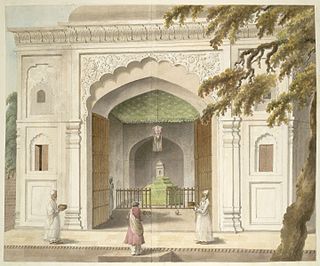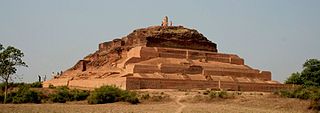
The history of Pakistan preceding the country's creation in 1947. Although, Pakistan was created in 1947 as a whole new country by the British through partition of India, but the history of the land extends much further back and is intertwined with that of Afghanistan, India, and Iran. Spanning the northwestern expanse of the Indian subcontinent and the eastern borderlands of the Iranian plateau, the region of present-day Pakistan served both as the fertile ground of a major civilization and as the gateway of South Asia to Central Asia and the Near East.

Punjab, also known as the Land of the Five Rivers, is a geopolitical, cultural, and historical region in South Asia. It is specifically located in the northwestern part of the Indian subcontinent, comprising areas of modern-day eastern-Pakistan and northwestern-India. Punjab's major cities are Lahore, Faisalabad, Rawalpindi, Gujranwala, Multan, Ludhiana, Amritsar, Sialkot, Chandigarh, Shimla, Jalandhar, Patiala, Gurugram, and Bahawalpur.

Pashtuns, also known as Pakhtuns, or Pathans, are a nomadic, pastoral, Eastern Iranic ethnic group primarily residing in northwestern Pakistan and southern and eastern Afghanistan. They historically were also referred to as Afghans until the 1970s after the term's meaning had become a demonym for members of all ethnic groups in Afghanistan.

The Hindu Kush is an 800-kilometre-long (500 mi) mountain range on the Iranian Plateau in Central and South Asia to the west of the Himalayas. It stretches from central and eastern Afghanistan into northwestern Pakistan and far southeastern Tajikistan. The range forms the western section of the Hindu Kush Himalayan Region (HKH); to the north, near its northeastern end, the Hindu Kush buttresses the Pamir Mountains near the point where the borders of China, Pakistan and Afghanistan meet, after which it runs southwest through Pakistan and into Afghanistan near their border.

The Delhi Sultanate or the Sultanate of Delhi was a late medieval empire primarily based in Delhi that stretched over large parts of the Indian subcontinent, for 320 years (1206–1526). Following the invasion of South Asia by the Ghurid dynasty, five dynasties ruled over the Delhi Sultanate sequentially: the Mamluk dynasty (1206–1290), the Khalji dynasty (1290–1320), the Tughlaq dynasty (1320–1414), the Sayyid dynasty (1414–1451), and the Lodi dynasty (1451–1526). It covered large swaths of territory in modern-day India, Pakistan, and Bangladesh as well as some parts of southern Nepal.

Rohilkhand is a region in the northwestern part of Uttar Pradesh, India, that is centered on the Bareilly and Moradabad divisions. It is part of the upper Ganges Plain, and is named after the Rohilla tribe of Pathans. The region was called Madhyadesh and Panchala in the Sanskrit epics Mahabharata and Ramayana. During the colonial era in India, the region was governed by the Royal House of Rampur.

Rohillas are a mixed Indian community of Pashtun heritage, historically found in Rohilkhand, a region in the state of Uttar Pradesh, India. It forms the largest Pashtun diaspora community in India, and has given its name to the Rohilkhand region. The Rohilla military chiefs settled in this region of northern India in the 1720s, the first of whom was Ali Mohammed Khan.

The Khalji or Khilji dynasty was the second dynasty which ruled the Delhi sultanate, covering large parts of the Indian subcontinent for nearly three decades between 1290 and 1320. It was founded by Jalal ud din Firuz Khalji.

Greater India, also known as the Indian cultural sphere, or the Indic world, is an area composed of several countries and regions in South Asia, East Asia and Southeast Asia that were historically influenced by Indian culture, which itself formed from the various distinct indigenous cultures of South Asia. It is an umbrella term encompassing the Indian subcontinent and surrounding countries, which are culturally linked through a diverse cultural cline. These countries have been transformed to varying degrees by the acceptance and introduction of cultural and institutional elements from each other. The term Greater India as a reference to the Indian cultural sphere was popularised by a network of Bengali scholars in the 1920s, but became obsolete in the 1970s.

Medieval India refers to a long period of post-classical history of the Indian subcontinent between the "ancient period" and "modern period". It is usually regarded as running approximately from the breakup of the Gupta Empire in the 6th century CE to the start of the early modern period in 1526 with the start of the Mughal Empire, although some historians regard it as both starting and finishing later than these points. The medieval period is itself subdivided into the early medieval and late medieval eras.

The Bareilly district belongs to the state Uttar Pradesh in northern India. Its capital is Bareilly city and it is divided in six administrative division or tehsils: Aonla, Baheri, Bareilly city, Faridpur, Mirganj, and Nawabganj. The Bareilly district is a part of the Bareilly Division and occupies an area of 4120 km2 with a population of 4,448,359 people according to the census of 2011.

Hinduism in Afghanistan is practiced by a tiny minority of Afghans, about 30-40 individuals as of 2021, who live mostly in the cities of Kabul and Jalalabad. Afghan Hindus are ethnically Pashtun, Hindkowan (Hindki), Punjabi, or Sindhi and primarily speak Dari, Pashto, Hindko, Punjabi, Sindhi, and Hindustani (Hindi-Urdu).
Ethnic groups in South Asia are ethnolinguistic groupings within the diverse populations of South Asia, including the countries of Bangladesh, Bhutan, India, Maldives, Nepal, Pakistan, and Sri Lanka. Afghanistan is variously considered to be a part of both Central Asia and South Asia, which means Afghans are not always included among South Asians, but when they are, South Asia has a total population of about 2.04 billion.
Jat Muslim or Musalman Jat, also spelled Jatt or Jutt, are an elastic and diverse ethno-social subgroup of the Jat people, who are composed of followers of Islam and are native to the northern regions of the Indian subcontinent. They are found primarily throughout the Sindh and Punjab regions of Pakistan. Jats began converting to Islam from the early Middle Ages onward and constitute a distinct subgroup within the diverse community of Jat people.

South Asia is the southern subregion of Asia, which is defined in both geographical and ethnic-cultural terms. As commonly conceptualized, the modern states of South Asia include Bangladesh, Bhutan, India, the Maldives, Nepal, Pakistan, and Sri Lanka, and with Afghanistan often included, which may otherwise be classified as part of Central Asia. South Asia borders East Asia to the northeast, Central Asia to the northwest, West Asia to the west and Southeast Asia to the east. Apart from Southeast Asia, Maritime South Asia is the only subregion of Asia that lies partly within the Southern Hemisphere. The British Indian Ocean Territory and two out of 26 atolls of the Maldives in South Asia lie entirely within the Southern Hemisphere. Topographically, it is dominated by the Indian subcontinent and is bounded by the Indian Ocean in the south, and the Himalayas, Karakoram, and Pamir Mountains in the north.

According to the epic Mahābhārata, Bareilly region (Panchala) is said to be the birthplace of Draupadi, who was also referred to as 'Panchali' by Kṛṣṇā. When Yudhishthira becomes the king of Hastinapura at the end of the Mahābhārata, Draupadi becomes his queen. The folklore says that Gautama Buddha had once visited the ancient fortress city of Ahicchattra in Bareilly. The Jain Tirthankara Parshva is said to have attained Kaivalya at Ahichhatra.

The history of Uttar Pradesh, a state in India, stretches back several millennia. The region shows the presence of human habitation dating back to between 85,000 and 73,000 years ago. Additionally, the region seems to have been domesticated as early as 6,000 BC.

The Kingdom of Rohilkhand was a late modern Indian kingdom under nominal Mughal suzerainty, that rose under the declining Mughal Empire in 1721 and continued to exist until 1774 when it was defeated by Oudh the British transformed its significantly reduced borders into the princely state of Rampur. Nawab Ali Mohammed Khan became the first Nawab of Rohilkhand, having been previously elected as overlord by various Afghan chiefs at the age of fourteen. He would carve out the future kingdom from the collapsing Mughal Empire and go on to the found the Rohilla dynasty. The crown would go on being held by the Rohillas until the kingdom came to an end in 1774, and thereafter the same dynasty would rule over Rampur.

The Rohilla dynasty was a dynasty that ruled over much of North-West Uttar Pradesh in the form of Rohilkhand and later until 1947, the Princely state of Rampur. At the height of their power the dynasty ruled over the Kingdom of Rohilkhand and held suzairnty over the Kingdom of Kumaon and Kingdom of Garhwhal.














